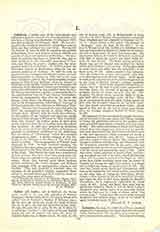

Labarum the name by which the military standard adopted by Constantine the Great after his celebrated vision (Lactatius, “De mortibus persecutorum”, c. xliv), was known in antiquity. The original labarum, designed under the emperor’s direction on the day subsequent to the appearance of the “cross of light”, is described by Eusebius (Vita Constant., I, 26) as “a long spear, overlaid with gold”, which with a transverse bar formed the figure of a cross. “On the top of the whole was fixed a wreath of gold and precious stones, and within this the symbol of the Savior’s name, two letters indicating the name of Christ by means of the initial letters, the letter X intersecting P at the center.” These two letters formed what is known as the monogram of Constantine, so called—not because it was the invention of this emperor, for it had been a familiar Christian symbol prior to his conversion, but—because of the great popularity it enjoyed from the date of its appearance on the imperial standards. From the crossbar of the spear, was suspended a purple banner with the Greek inscription TOUTO NIKA—i.e. conquer by this (sign), usually rendered in Latin “In hoc signo vinces” (in this sign thou shalt conquer). This banner, square in form, covered with a rich embroidery of precious stones, and “being also richly interlaced with gold, presented an indescribable degree of beauty to the beholder”. The part of the staff immediately above the embroidered banner was adorned with medallions of the emperor and his children. Fifty soldiers of the imperial guard, distinguished for bravery and piety, were entrusted with the care and defense of the new sacred standard (Vita Constant., II, 8). Standards, similar to the original labarum in its essential features, were supplied to all the legions, and the monogram was also engraved on the soldiers’ shields. An idea of some of the deviations in form of the standards furnished to different divisions of the army may be obtained from several coins of Constantine’s reign still preserved. On one coin, for instance, the portraits of the emperor and his sons are represented on the banner instead of on the staff; on a second the banner is inscribed with the monogram and surmounted by the equal-armed cross, while the royal portraits, though on the shaft, are below instead of above the banner. In form, the labarum of Constantine was an adaptation of the already existing cavalry standard of the Roman army (Dict. of Christ. Antiq., s.v.); the pagan emblems were merely replaced by Christian symbols. The term labarum, which is of uncertain derivation, was probably familiar in the Roman army from the reign of Hadrian.
MAURICE M. HASSETT

